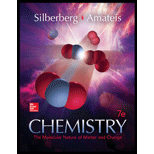
Concept explainers
(a)
Interpretation:
The number
Concept introduction:
Scientific notations are used to express the given large or small quantities in a compact way by making use of exponents.
The general representation of scientific notation is,
Here,
The decimal point is shifted towards right or left such that only one nonzero digit is present to the left of the decimal point and the number of places the decimal point is shifted is expressed as the exponent power. If the decimal point is shifted towards right from its original place a negative exponent result and vice-versa.
(b)
Interpretation:
The number
Concept introduction:
Scientific notations are used to express the given large or small quantities in a compact way by making use of exponents.
The general representation of scientific notation is,
Here,
The decimal point is shifted towards right or left such that only one nonzero digit is present to the left of the decimal point and the number of places the decimal point is shifted is expressed as the exponent power. If the decimal point is shifted towards right from its original place a negative exponent result and vice-versa.
(c)
Interpretation:
The number
Concept introduction:
Scientific notations are used to express the given large or small quantities in a compact way by making use of exponents.
The general representation of scientific notation is,
Here,
The decimal point is shifted towards right or left such that only one nonzero digit is present to the left of the decimal point and the number of places the decimal point is shifted is expressed as the exponent power. If the decimal point is shifted towards right from its original place a negative exponent result and vice-versa.
(d)
Interpretation:
The number
Concept introduction:
Scientific notations are used to express the given large or small quantities in a compact way by making use of exponents.
The general representation of scientific notation is,
Here,
The decimal point is shifted towards right or left such that only one nonzero digit is present to the left of the decimal point and the number of places the decimal point is shifted is expressed as the exponent power. If the decimal point is shifted towards right from its original place a negative exponent result and vice-versa.
Want to see the full answer?
Check out a sample textbook solution
Chapter 1 Solutions
Student Study Guide for Silberberg Chemistry: The Molecular Nature of Matter and Change
- Provide the complete mechanism for the reactions below. You must include appropriate arrows,intermediates, and formal charges.arrow_forwardIndicate the products obtained by reacting fluorobenzene with a sulfonitric mixture.arrow_forwardIf I have 1-bromopropene, to obtain compound A, I have to add NaOH and another compound. Indicate which compound that would be. C6H5 CH3arrow_forward
- If I have 1-bromopropene and I want to obtain (1,1-dipropoxyethyl)benzene, indicate the compound that I should add in addition to NaOH.arrow_forwardDraw the major product of this reaction. Ignore inorganic byproducts. Ο HSCH2CH2CH2SH, BF3 Select to Draw I Submitarrow_forwardFeedback (7/10) Draw the major product of this reaction. Ignore inorganic byproducts. Assume that the water side product is continuously removed to drive the reaction toward products. Incorrect, 3 attempts remaining Ο (CH3CH2)2NH, TSOH Select to Draw V N. 87% Retryarrow_forward
- If I want to obtain (1,1-dipropoxyethyl)benzene from 1-bromopropene, indicate the product that I have to add in addition to NaOH.arrow_forwardIndicate the products obtained when fluorobenzene reacts with a sulfonitric acid mixture (HNO3 + H2SO4). Indicate the majority if necessary.arrow_forwardIndicate the products obtained when chlorobenzene acid reacts with a sulfonitric acid mixture (HNO3 + H2SO4). Indicate the majority if necessary.arrow_forward
- Indicate the products obtained by reacting benzenesulfonic acid with a sulfonitric acid mixture (HNO3 + H2SO4). Indicate the majority if necessary.arrow_forwardIndicate the products obtained by reacting ethylbenzene with a sulfonitric acid mixture (HNO3 + H2SO4). Indicate the majority if necessary.arrow_forwardIndicate the products obtained when tert-butylbenzene reacts with a sulfonitric acid mixture (HNO3 + H2SO4). Indicate the majority if necessary.arrow_forward
 ChemistryChemistryISBN:9781305957404Author:Steven S. Zumdahl, Susan A. Zumdahl, Donald J. DeCostePublisher:Cengage Learning
ChemistryChemistryISBN:9781305957404Author:Steven S. Zumdahl, Susan A. Zumdahl, Donald J. DeCostePublisher:Cengage Learning ChemistryChemistryISBN:9781259911156Author:Raymond Chang Dr., Jason Overby ProfessorPublisher:McGraw-Hill Education
ChemistryChemistryISBN:9781259911156Author:Raymond Chang Dr., Jason Overby ProfessorPublisher:McGraw-Hill Education Principles of Instrumental AnalysisChemistryISBN:9781305577213Author:Douglas A. Skoog, F. James Holler, Stanley R. CrouchPublisher:Cengage Learning
Principles of Instrumental AnalysisChemistryISBN:9781305577213Author:Douglas A. Skoog, F. James Holler, Stanley R. CrouchPublisher:Cengage Learning Organic ChemistryChemistryISBN:9780078021558Author:Janice Gorzynski Smith Dr.Publisher:McGraw-Hill Education
Organic ChemistryChemistryISBN:9780078021558Author:Janice Gorzynski Smith Dr.Publisher:McGraw-Hill Education Chemistry: Principles and ReactionsChemistryISBN:9781305079373Author:William L. Masterton, Cecile N. HurleyPublisher:Cengage Learning
Chemistry: Principles and ReactionsChemistryISBN:9781305079373Author:William L. Masterton, Cecile N. HurleyPublisher:Cengage Learning Elementary Principles of Chemical Processes, Bind...ChemistryISBN:9781118431221Author:Richard M. Felder, Ronald W. Rousseau, Lisa G. BullardPublisher:WILEY
Elementary Principles of Chemical Processes, Bind...ChemistryISBN:9781118431221Author:Richard M. Felder, Ronald W. Rousseau, Lisa G. BullardPublisher:WILEY





